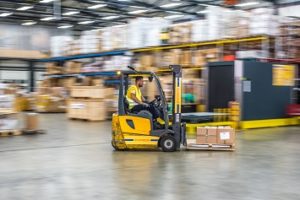The Occupational Safety and Health Administration (OSHA) has extensive regulations for forklift design and maintenance, operations, and training that all employers that use these vehicles must comply with. There are also additional requirements that depend on the classification of a forklift and its use.

simonkr / E+ / Getty Images
Yesterday we focused on general compliance tips for forklift design and maintenance and operations. Today we will look at training requirements for forklift operators.
Under 18? No Driving a Forklift!
To begin with, don’t let any workers under 18 years of age operate a forklift—it’s against the law.
General Forklift Training Compliance Tips
Workers must successfully complete a training program before operating a forklift. All operator training and evaluation must be conducted by someone who has the knowledge, training, and experience to train forklift operators and evaluate their competence.
Forklift training tips include:
- Make sure workers are properly trained in the use of the type of industrial truck they operate.
- Allow only trained workers to operate forklifts.
- Maintain records certifying that each operator has been trained and evaluated. The written certification record must include the name of the operator, the date of the training, the date of the evaluation, and the identity of the person(s) performing the training or evaluation. There is no specific retention period for these records.
- If an operator will be expected to operate different types of vehicles, training must address the unique characteristics of each type of vehicle the worker is expected to operate.
- When an attachment is used on the truck to move odd-shaped materials, the operator training must include instruction on the safe conduct of those operations so that the operator knows and understands the restrictions or limitations created by each vehicle’s use.
- Train workers in all operating instructions, warnings, and precautions listed in the operator’s manual for the type of vehicle that the employee is being trained to operate. This includes restraint systems, such as seat belts, when they are addressed in the operating instructions (required for forklifts manufactured after 1992).
- Tell forklift operators that they’re required to use seat belts, and enforce your policy the way you do all your other safety rules. (Lax enforcement of seat belt rules is frequently cited as an important reason so many operators fail to use them.)
- Recount stories of forklift injuries and deaths, and if you can, use pictures of some of these accidents. Some employees may scoff, but that ugly picture is going to stick with them somewhere in the back of their minds—and it might just make them snap on the belt.
- Remind them that no matter how much a nuisance wearing a seat belt might be, it’s worth it to ensure that they can go home to their families and friends safely.
- Every 3 years, a trainer or someone experienced operating forklifts must observe the forklift operator perform forklift operations at the operator’s 3rd anniversary, not over the past 3 years.
- In addition to the 3-year evaluation, the operator must be evaluated and receive refresher training anytime the employee operates the vehicle in an unsafe manner, has been involved in an accident or near-miss incident, is assigned to drive a different kind of truck, or there are changes in workplace conditions that could affect safe operation of the truck.
Takeaway for EHS Managers
According to OSHA, the top 10 list of frequently cited safety and health violations rarely changes. Violations of forklift standards are consistently on the list. Determining the best way to protect workers from injury largely depends on the type of truck operated and the worksite where it is being used. You must ensure that each forklift operator is competent to operate a forklift safely, as demonstrated by the successful completion of the training and evaluation. Small businesses that use forklifts should consider these general training compliance points for workers who operate forklifts.
